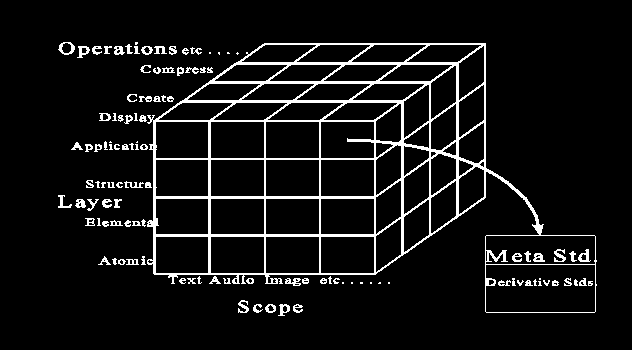


Next: Conclusion
Up: A Reference Model for
Previous: Problem Definition
The following then is a starting point for a reference
model for data interchange standards.
- The model might have four layers:
- The Atomic Layer represents basic data forms.
Things such as UNICODE, ASCII, CCITT Group 3 Fax,
PCM, and RGB triplets would fall at this level.
Basically, this is the smallest meaningful unit
in any system. Below the atomic level, the
analysis or manipulation of data would not be
meaningful.
- The Elemental Layer would provide some format for
excapsulating atomic data. TIF, GIF, WAV would
provide examples at this level. An elemental
form provides minimal additional data, but does
provide additional data that allows the atom
stream to be interpreted. For example, a stream
of RGB triplets that constitutes an image does
not specify the number of bits for each sample,
or the orders of the samples, or the size of the
image. These are all things that might be
specified at the elemental level.
- The Structural layer would provide two additional
aspects of complexity. First, this would be the
first level at which multiple types of atomic
elements would be allowed. Second, it would be
at this level that we would specify the
structural relationships between elements. Thus,
in SGML, we can include text as well as graphics
and specify how they are related. Examples of
Standards at this level, moving from simple to
complex would include XDR, ASN.1, SGML, ODA, and
the EDI framework.
- The Application layer would deal with standards
that make use of structural layer standards to
accomplish some application specific goal.
Examples of standards at this level include CALS,
TEI, STEP, and specific EDI transaction sets.
- The model scopes data forms. At the atomic layer
the scope definition insures that all appropriate
data forms are covered. At higher layers --
structural and application -- standards would
reference atomic and elemental standards as a way
of defining their data scope.
 Thus we might be
concerned with the following data forms at the
atomic level
Thus we might be
concerned with the following data forms at the
atomic level :
:
- symbolic
- text
- non-text(music, math, logic, etc.)
- graphic
- audio
- image
- video
- The model maps representations to tightly coupled
operations and standards defined for these
operations.. This might involve the standardization
of operation categories into groups such as
creation, display, storage, and retrieval. This
was suggested as one model for defining standards
by Spring and Carbo-Bearman.
 Similar
efforts will be required by OLE and CORBA as they
mature. In terms of historical precedent, the
Graphic Kernel System is a display standard for
Computer Graphics Metafile representations of
graphics. The Common Command Language is a
retrieval standard for text elements. Similarly
the Basic Encoding Rules are a transmission rules
for data elements defined by ASN.1.
Similar
efforts will be required by OLE and CORBA as they
mature. In terms of historical precedent, the
Graphic Kernel System is a display standard for
Computer Graphics Metafile representations of
graphics. The Common Command Language is a
retrieval standard for text elements. Similarly
the Basic Encoding Rules are a transmission rules
for data elements defined by ASN.1.
- Finally, the model needs some clear way to show the
relationship between syntactic meta standards such
as ASN.1 and SGML and standards derived from them
such as CALS, HTML, TEI, and Z39.59 in the case of
SGML.
This leaves us then with a beginning picture of the
framework for examining and thinking about data
interchange standards. That framework might take
something along the following form:




Next: Conclusion
Up: A Reference Model for
Previous: Problem Definition
Michael Spring
Sat Apr 6 10:34:46 EST 1996
